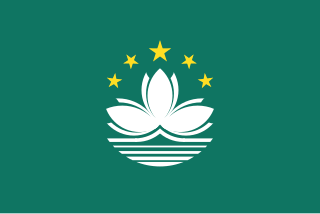
Macau or Macao, officially the Macao Special Administrative Region of the People's Republic of China (MSAR), is a city and special administrative region of China in the western Pearl River Delta by the South China Sea. With a population of about 680,000 and an area of 32.9 km2 (12.7 sq mi), it is the most densely populated region in the world.

Macau is a Special Administrative Region (SAR) of the People's Republic of China. In 1557 it was leased to Portugal as a trading post in exchange for a symbolic annual rent of 500 tael in order to stay in Macau, it remained under Chinese sovereignty and authority until 1887, the Portuguese came to consider and administer it as a de facto colony. Following the signing of the Treaty of Nanking between China and Britain in 1842, and the signing of treaties between China and foreign powers during the 1860s, establishing the benefit of "the most favoured nation" for them, the Portuguese attempted to conclude a similar treaty in 1862, but the Chinese refused, owing to a misunderstanding over the sovereignty of Macau. In 1887 the Portuguese finally managed to secure an agreement from China that Macao was Portuguese territory. In 1999 it was handed over to China. Macau was the last extant European territory in continental Asia.

Transport in Macau includes road, sea, rail and air transport. Road transport is the primary mode of transport within Macau, although a new rail system opened in December 2019 serving the areas of Taipa and Cotai. The main forms of public transport are buses and taxis.

The People's Liberation Army Macao Garrison is a garrison of the People's Liberation Army (PLA), responsible for defense duties in the Macau Special Administrative Region (SAR) since the sovereignty of Macau was transferred to China in 1999.
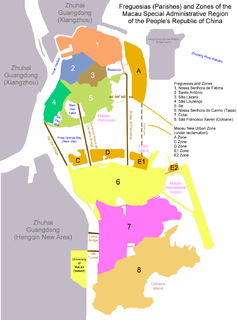
By the end of Portuguese rule, Macau was administratively divided into two municipalities and seven civil parishes. Parishes were administrative subdivisions of the municipalities. After the 1999 handover to China, parishes are still officially recognized divisions but for symbolic reasons only.
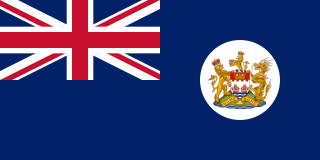
British Forces Overseas Hong Kong comprised the elements of the British Army, Royal Navy and Royal Air Force stationed in British Hong Kong. The Governor of Hong Kong also assumed the position of the Commander-in-chief of the forces and the Commander British Forces in Hong Kong took charge of the daily deployment of the troops. Much of the British military left prior to the handover of Hong Kong to China in 1997. The present article focuses mainly on the British garrison in Hong Kong in the post Second World War era. For more information concerning the British garrison during the Second World War and earlier, see the Battle of Hong Kong.

The People's Liberation Army Hong Kong Garrison is a garrison of the People's Liberation Army (PLA), responsible for defence duties in the Hong Kong Special Administrative Region (SAR) since the sovereignty of Hong Kong was transferred to China in 1997. Prior to the handover of Hong Kong, the territory was under British rule, and the defence of the territory was the responsibility of the British Forces Overseas Hong Kong, with auxiliary help from the Royal Hong Kong Regiment.
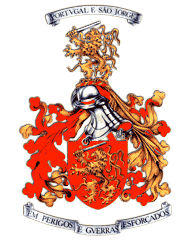
The Portuguese Army is the land component of the Armed Forces of Portugal and is also its largest branch. It is charged with the defence of Portugal, in co-operation with other branches of the Armed Forces. With its origins going back to the 12th century, it can be considered one of the oldest active armies in the world.

The Outer Harbour Ferry Terminal, also known as the Macau Maritime Ferry Terminal, Macau Ferry Terminal or Hong Kong-Macau Ferry Pier in Chinese, is a ferry terminal located at Porto Exterior, Sé, Macau, China.
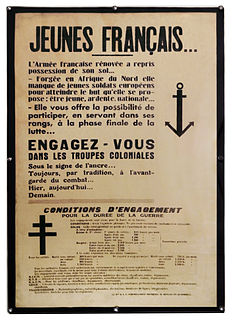
Colonial troops or colonial army refers to various military units recruited from, or used as garrison troops in, colonial territories.

The Fire Services Bureau is responsible for fire and rescue services in Macau. Volunteer fire brigades in Macau dates back to 1851 and full-time department in 1883. Prior to 1851, the Portuguese military provided fire services in the colony. In 1999, the CB became a fully civilian agency. Today the department is organized under the Macau Security Force. The brigade is responsible for fire and rescue for both land and air.

The Portuguese Marine Corps constitutes the Elite Commando Raid Force and Special Operations branch of the Portuguese Navy. It has roles similar to the ones of the USMC Reconnaissance Battalions and of the Royal Marine Commandos. The Corps is specialised in amphibious warfare, coastal reconnaissance, unconventional warfare, guerrilla warfare, raids, maritime interdiction and boarding operations. It is an elite light infantry force, operating as a rapid-reaction force. Today’s Corpo de Fuzileiros is the premier raid force. The fuzileiros remains an all-volunteer force with an intensive screening and selection process followed by combat-focused training. Fuzileiros are resourced to maintain exceptional proficiency, experience and readiness.
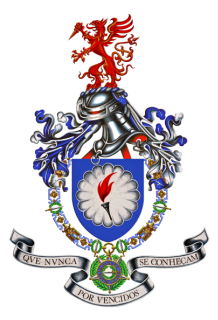
The Regimento de Paraquedistas, based in Tancos, Portugal, is a unit of the Portuguese Army and serves as the instruction center for recruitment and training of the Portuguese paratroopers. This unit includes an entire battalion, acting as support and reserve for airborne units which contains for example, military war dogs and airborne pathfinders and an instruction battalion responsible for the forming of new paratroopers.
Articles related to Macau include:
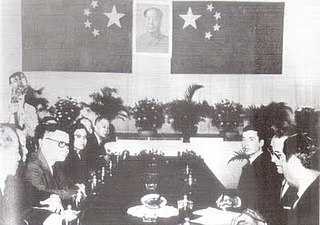
The 12-3 incident refers to political demonstrations and rioting against Portuguese rule in Macau that occurred on 3 December 1966. The incident, inspired by the Cultural Revolution in the People's Republic of China, occurred in direct response to a violent police crackdown by the Portuguese colonial authorities against local Chinese protestors demonstrating against corruption and colonialism in Macau. The incident is known as "12-3", in reference to the date of the riots.
Fernando Augusto Colaço Leal Robles or Fernando Robles is a Portuguese former Second Lieutenant who participated in initial counterinsurgency operations against insurgent União dos Povos de Angola (UPA) guerrillas operating in northern Angola during 1961, at the onset of the Portuguese Colonial War. He was born in Coimbra.

The Caçadores (hunters) were the elite light infantry troops of the Portuguese Army, in the late 18th and early 19th centuries. Units of Caçadores – with features somewhat different from the original ones – continued to exist in the Portuguese Armed Forces until the 1970s, namely the Caçadores Especiais – several special forces companies of the Portuguese Army created by the Special Operations Troops Centre at the beginning of the 1960s and heavily employed throughout the Portuguese Colonial War (1961-1974) in Africa.

The electricity sector in Macau ranges from generation, transmission, distribution and sales of electricity in Macau, China.

The South China Sea raid was an operation conducted by the United States Third Fleet between 10 and 20 January 1945 during the Pacific War of World War II. The raid was undertaken to support the liberation of Luzon in the Philippines, and targeted Japanese warships, supply convoys and aircraft in the region.

















